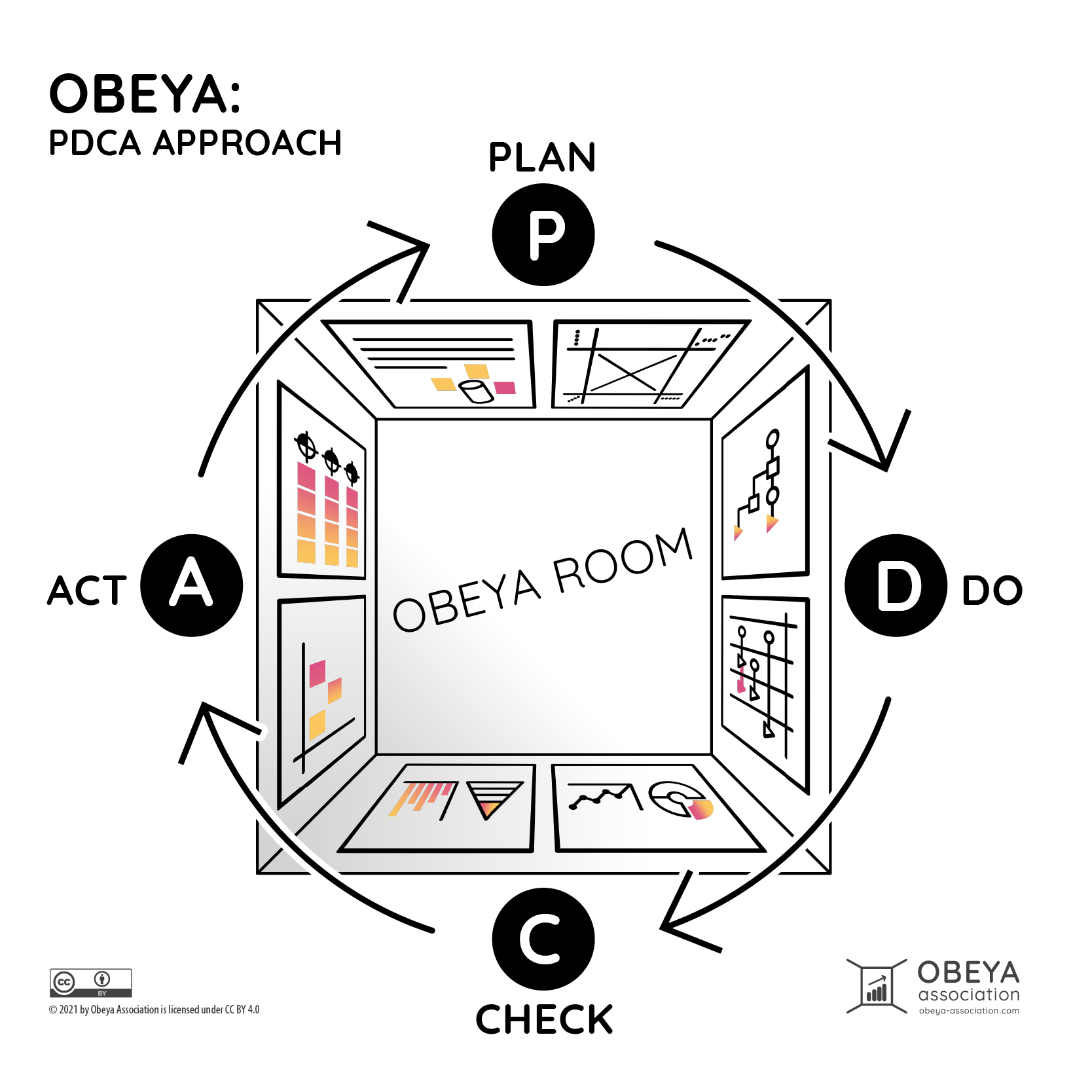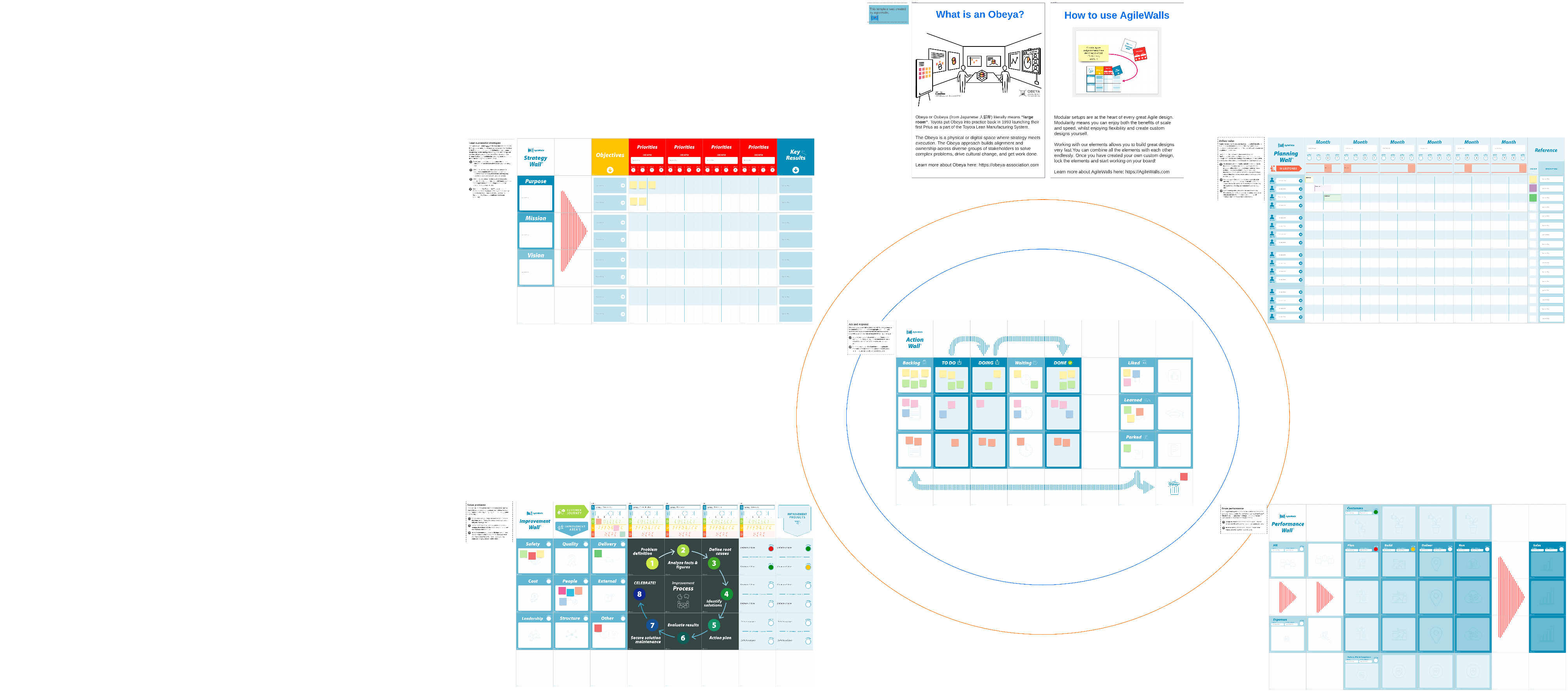
Benefits of using a digital Obeya room for strategic alignment
Reading time: about 7 min
Topics:
An organization’s ability to make and execute on strategic decisions is dependent on collaboration, communication, and knowledge-sharing. Getting all the key players on the same page is tricky enough in person, but hybrid work has complicated decision-making even more, with disconnected teams and scattered information.
Leaders looking to align their organization and increase efficiency from strategy to execution can turn to Obeya as their strategic guide.
What is an Obeya?
Obeya is a philosophy, a process, a means of communication, and a proven system for cross-functional cooperation within an organization. Taken from the Japanese word for “large room,” Obeya functions as a control center where people discuss big-picture issues of a project, brainstorm ideas, and ask questions.
Obeya is typically practiced within an Obeya room, a central space that houses all relevant project information, typically with posters, graphs, whiteboards, and sticky notes. With its 11 principles, the Obeya room combines substantive impact along with visual appeal.

Obeya’s roots date back to the ancient wisdom of Confucius and his philosophies around the art of management. These philosophies emphasize the importance of continuous improvement, based on reflection and learning from experiences.
More recently, Obeya was popularized as a management practice by Takeshi Uchiyamada, Toyota’s Chief Engineer during the 1990s. Working under a tight deadline to create the first mass-produced hybrid vehicle, Uchiyamada realized success was dependent on integrating everyone’s efforts at once.
This meant meeting with representatives from engineering, design, production, marketing, and sales several times each week—essentially, anyone with a hand in the final product. This tireless pursuit of inclusive and sustainable decision-making now defined as Obeya resulted in the Prius.
Released in Japan in 1997 more than a decade ahead of its competitors, and worldwide in 2000, the Prius revolutionized the automotive industry—still ranking high among hybrid vehicles today. Not long after Toyota’s success with the Prius, other companies followed suit by using their own Obeya rooms to improve team efficiency, creativity, and problem-solving.
With the normalization of remote teams and continual adoption of hybrid work, the Obeya room has now gone digital.
To learn more about how hybrid organizations can use Obeya, we talked to Bart Bongers, founder of the Obeya Association and AgileWalls. Bongers drew on his extensive experience as an Agile coach and certified Lean Six Sigma Black Belt to share insights on the history of Obeya, how Obeya can be used digitally, and the benefits that virtual Obeya rooms provide.
The traditional Obeya room versus the digital Obeya room
Unlike the traditional Obeya room, a digital Obeya room can be accessed at any time, anywhere. No longer limited to physical spaces that require permission to leave printouts on walls, a digital Obeya room can be quickly and easily reconfigured as necessary.
Better yet, all team members throughout an organization can remain involved and engaged with a digital Obeya room, regardless of geographic or time-zone constraints.
The digital Obeya room is a virtual space that only requires online access and an invitation to participate. Images, diagrams, notes, and flowcharts can be easily added, updated, shared, and viewed in real time or asynchronously—in whichever form makes the most sense for your team.
“The benefits of being physically present in an Obeya Room are substantial, as Obeya thrives on human connection for inclusive and sustainable decision-making,” said Bongers. “On the other hand, digital Obeya rooms allow us to access an Obeya ‘Any Time, Any Where, on Any Device (ATAWAD)’. This connects geographically distributed teams and organizations in a way that has never been done before.”
Whether traditional or digital, the power of the Obeya room is that it instills discipline by establishing routines for collaboration, business management, and problem resolution.
Benefits of a digital Obeya room in strategic alignment
In the past, high-performing Agile teams were in their element when working in close proximity to one another, sharing a workspace filled with sticky notes, whiteboards, and other visual expressions of work. The digital Obeya room helps to recreate this experience for hybrid teams.
Virtual Obeya rooms act as a blueprint for your business by connecting business strategy to the actual work being performed, allowing everyone to contribute to and align on key initiatives. Bongers explained:
“The Obeya model makes it possible to design for collaboration since it’s an inclusive organizational model that differs significantly from traditional hierarchical models.”
The digital Obeya room provides other distinct advantages, particularly for hybrid teams:
- Centralizes information for everyone to access from wherever. A digital Obeya establishes a single source of truth across your organization and is accessible to all team members regardless of where they’re working. This helps overcome the problem of trying to find relevant information from poorly organized or unvetted content. An Obeya prioritizes and discerns what your team needs to look at when, where, and why.
- Bridges cross-functional silos and aligns teams. Departments exist within organizations to combine the efforts of subject-matter experts to complete specific tasks. The Obeya room brings managers together across an organization, providing them with a clear view of what everyone else is working on, along with the how and why. By virtue of the Obeya, leaders can see whether their current strategies support or hinder their counterparts.
- Lends to continuous improvement. Through the lens of Obeya, imperfections or failures offer unique opportunities for improvement or growth. By encouraging a heightened level of transparency, Obeya naturally sets up a disciplined and recurring rhythm of refinement at each cycle—backed by facts, data, and learnings from any prior mishaps along the way.
- Encourages collaboration and increases engagement. Successful collaboration is more than mere tactics or strategies. It involves an intentional, ongoing, and dynamic process, which is precisely what a digital Obeya room provides. With features to democratize idea-sharing, digital Obeyas inspire participation and get people out of their comfort zone, ready to engage.
Tips for making the most out of a digital Obeya room
There are multiple methods for practicing Obeya, but almost all consist of the PDCA cycle: Plan, do, check, act. Each part of the cycle helps achieve specific objectives:
- Plan: Define your vision and strategy for addressing a problem.
- Do: Give an overview of the work in progress.
- Check: Evaluate your plan based on feedback and data.
- Act: Put your learnings to work—what changes will you make short- and long-term?

Putting together an Obeya room doesn’t need to be complicated. It’s especially simple with a template to build alignment and ownership across diverse stakeholder groups.
Modular jigsaw design elements make designing your digital Obeya room effective, easy, and fun. Within the Lucidspark AgileWalls Obeya template, you can define your team’s overarching purpose, mission, and vision using the provided text boxes or by adding your own sticky notes.
The Obeya template’s modularity gives you the benefit of scale and speed, while also enjoying the flexibility to create custom designs of your own with all the elements featured on the board.

In order to get the most value out of digital Obeyas, Bongers emphasized the importance of connection and collaboration:
“Human connection is what makes the Obeya philosophy so powerful, so organizations should pay close attention to the human aspect when using digital Obeya rooms.“
Keep these tips in mind to maximize your digital Obeya experience:
- Look for ways to prioritize the most important information in your virtual Obeya room. “Without the spatial restrictions of a physical room, it’s easy to overload digital Obeyas with information,” said Bongers. “Lack of space forces us to make choices, which is a good thing.”
- Select an Obeya host whose primary focus is on fostering effective collaboration and improving process quality.
- Take steps to keep the information shared in your virtual space secure. Ensure you’ve set the appropriate permissions and access settings when preparing a digital Obeya room.
- For the best of both worlds, try to alternate between a physical and digital Obeya room. “Remember, the true value of Obeya is in the exchange of information through collaborative conversations, not the quality of visuals,” said Bongers.
Of course, the most important tip of all is getting a digital Obeya room started in the first place.
When it comes to creating a more intuitive and dynamic digital Obeya room, Lucidspark’s online virtual whiteboard gives hybrid teams an unparalleled experience—complete with collaborative features like chat and commenting, freehand drawing, emoji reactions, and collaborator colors to promote inclusive, interactive engagement.

Get started with the digital Obeya template.
Try nowAbout Lucid
Lucid Software is the leader in visual collaboration and work acceleration, helping teams see and build the future by turning ideas into reality. Its products include the Lucid Visual Collaboration Suite (Lucidchart and Lucidspark) and airfocus. The Lucid Visual Collaboration Suite, combined with powerful accelerators for business agility, cloud, and process transformation, empowers organizations to streamline work, foster alignment, and drive business transformation at scale. airfocus, an AI-powered product management and roadmapping platform, extends these capabilities by helping teams prioritize work, define product strategy, and align execution with business goals. The most used work acceleration platform by the Fortune 500, Lucid's solutions are trusted by more than 100 million users across enterprises worldwide, including Google, GE, and NBC Universal. Lucid partners with leaders such as Google, Atlassian, and Microsoft, and has received numerous awards for its products, growth, and workplace culture.
Related articles
How value streams increase agility for hybrid organizations
Learn how leaders who embrace value streams can accelerate their organization’s agile transformation in this blog by Jeff Rosenbaugh, Sr. Director of Professional Services, Lucid.
3 steps to aligning executives for effective change management
Learn how to conquer change management by establishing executive alignment first in this guest blog post by ExperiencePoint.
The warning signs and risks of poor organizational alignment
Achieving organizational alignment requires recognizing the risks and warning signs of misalignment and taking steps to enable cross-functional alignment.
How to use Lucid to strengthen remote and hybrid collaboration
Learn how to supercharge your collaboration skills and drive better results using Lucid.
